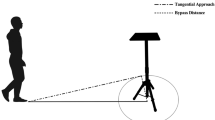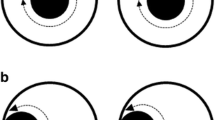Abstract
Gaze following allows individuals to detect the locus of attention of both conspecifics and other species. However, little is known about how this ability develops. We explored the emergence of bobwhite quail hatchlings’ ability to track human gaze by assessing their avoidance behavior in an open arena under five testing conditions: (1) a Direct Gaze condition, in which an experimenter looking down was positioned above one of two approach areas; (2) a Gaze Follow condition in which an experimenter, positioned equidistant between two approach areas, directed his/her gaze towards one of the areas; (3) a Masked Gaze Follow condition, in which the experimenter wore a mask during the Gaze Follow test; (4) a Deprived Face Experience condition, in which hatchlings were deprived of experience with human faces prior to the Gaze Follow test; and (5) a Control condition in which no experimenter was present during testing. Results revealed that hatchlings from the Direct Gaze condition preferred the non-gazed approach area at all ages tested. Hatchlings from the Gaze Follow condition preferred the non-gazed approach area at 48 and 72 h, but not at 24 h of age. In contrast, hatchlings from the Masked Gaze Follow, Deprived Face and Control conditions did not prefer either approach area at any age tested. These results indicate that experience with human faces plays a key role in the rapid emergence of gaze following behavior in bobwhite quail hatchlings.



Similar content being viewed by others
References
Bugnyar T, Stowe M, Heinrich B (2004) Ravens, Corvus corax, follow gaze direction of humans around obstacles. Proc R Soc B 271:1331–1336
Emery NJ (2000) The eyes have it: the neuroethology, function and evolution of social gaze. Neurosci Behav Rev 24:581–604
Flom R, Lee K, Muir D (2007) Gaze-following: its development and significance. Erlbaum, Mahwah
Gallup GG, Nash RF, Ellison AL (1971) Tonic immobility as a reaction to predation: artificial eyes as a fear stimulus for chickens. Psychon Sci 23:79–80
Gallup GG, Cummings WH, Nash RF (1972) The experimenter as an independent variable in studies of animal hypnosis in chickens (Gallus gallus). Anim Behav 20:166–169
Heaton MB, Miller DB, Goodwin DG (1978) Species-specific auditory discrimination in bobwhite quail neonates. Dev Psychobiol 11:13–21
Johnson MH, Farroni T (2003) Perceiving and acting on the eyes: the development and neural basis of eye gaze perception. In: Pascalis O, Slater A (eds) The development of face processing in infants and early childhood. Nova Science, Hauppauge, pp 155–167
Kaminski J, Bräuer J, Call J, Tomasello M (2001) Goats follow the visual gaze of conspecifics. Adv Ethol 36:174–180
Lickliter R, Hellewell T (1992) Contextual determinants of auditory learning in bobwhite quail embryos and hatchlings. Dev Psychobiol 25:1–24
Lickliter R, Lewkowicz DJ (1995) Intersensory experience and early perceptual development: attenuated prenatal sensory stimulation affects postnatal auditory and visual responsiveness in bobwhite quail chicks. Dev Psychol 31:609–618
Miklósi A, Polgárdi R, Topál J, Csányi V (1998) Use of experimenter-given cues in dogs. Anim Cogn 1:113–121
Moore C, Dunham PJ (1995) Joint attention: its origins and role in development. Erlbaum, Hillsdale
Mundy P, Kasari C, Sigman M (1992) Joint attention, affective sharing, and intersubjectivity. Infant Behav Dev 15:377–381
Peignot P, Anderson JR (1999) Use of experimenter-given manual and facial cues by gorillas (Gorilla gorilla) in an object-choice task. J Comp Psychol 113:253–260
Povinelli DJ, Bierschwale DT, Reaux JE, Cech CG (1999) Comprehension of seeing as a referential act in young children, but not juvenile chimpanzees. Br J Dev Psychol 17:37–60
Ristau CA (1991) Aspects of the cognitive ethology of an injury-feigning bird, the piping plover. In: Ristau CA (ed) Cognitive ethology: the minds of other animals. Erlbaum, Hillsdale, pp 91–126
Rosa Salva O, Regolin L, Vallortigara G (2007) Chicks discriminate gaze with their right hemisphere. Behav Brain Res 177:15–21
Schloegl C, Kotrschal K, Bugnyar T (2007) Gaze following in common ravens: ontogeny and habituation. Anim Behav 74:769–778
Tomasello M (1995) Joint attention and social cognition. In: Moore C, Dunham P (eds) Joint attention: its origins and role in development. Erlbaum, Hillsdale, pp 103–130
Vallortigara G, Zanforlin M (1988) Open-field behavior of young chicks (Gallus gallus): antipredatory responses, social reinstatement motivation, and gender effects. Anim Learn Behav 16:359–362
Watve M, Thakar J, Kale A, Puntambekar S, Shaikh I, Vaze K, Jog M, Paranjape S (2002) Bee-eaters (Merops orientalis) respond to what a predator can see. Anim Cogn 5:253–259
Acknowledgments
This research was supported by grants NICHD RO1 HD048423 and NIGMS R25 GM61347. Data was collected at the Developmental Psychobiology Lab at Florida International University. Animal care and use complied with both institutional and federal (NIH) guidelines, as well as the ethical standards for the treatment of animals endorsed by the American Psychological Association and the International Society for Developmental Psychobiology.
Author information
Authors and Affiliations
Corresponding author
Rights and permissions
About this article
Cite this article
Jaime, M., Lopez, J.P. & Lickliter, R. Bobwhite quail (Colinus virginianus) hatchlings track the direction of human gaze. Anim Cogn 12, 559–565 (2009). https://doi.org/10.1007/s10071-009-0214-3
Received:
Revised:
Accepted:
Published:
Issue Date:
DOI: https://doi.org/10.1007/s10071-009-0214-3




